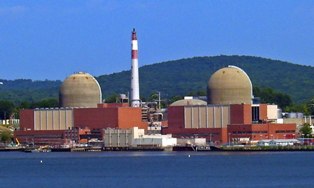New York state has followed neighbouring New Jersey in introducing draft policy requiring certain industrial facilities, including nuclear power plants, to construct cooling towers. The move could cost nuclear operators in the state over $2 billion to comply.
 |
| Cooling towers would be a highly costly addition to the Indian Point plant (Image: Entergy) |
The proposed policy would apply to nearly all facilities designed to withdraw 20 million or more gallons of water per day and that require a State Pollution Discharge Elimination System (SPDES) permit - unless an operator can demonstrate that closed cycle cooling technology cannot physically be implemented at a particular location. In such as case, DEC will require other technologies to achieve essentially the same level of protection for aquatic life as closed cycle cooling. Such determinations, DEC said, are made when an operator applies for or renews a SPDES permit.
The six nuclear reactors in the state - which supply almost one-third of electricity - may require some $2 billion in investment to continue operating.
DEC said: "Steam-electric stations such as fossil fuel and nuclear generating plants use by far the greatest volume of cooling water from our lakes, rivers and marine district." New York steam-electric plants use over six trillion gallons of cooling water annually, resulting in the impingement and entrainment of more than 17 billion fish of all life stages each year, according to DEC estimates.
According to DEC, unlike a "once through" cooling process where water is drawn from a lake or river and subsequently discharged back into it, closed cycle cooling technology re-circulates the water instead of discharging it after one use, reducing the impacts on aquatic life by more than 90%. It said that the policy "will add significant protections for New York's vital fisheries by slashing water intake at certain power plants and other industrial facilities."
DEC said that BTA determinations at both new and existing plants can include many different mitigative technologies and often more than one technology is required at a single facility. However, it noted that "mitigation is aimed at minimizing adverse environmental impacts, but not at a social and economic cost that is wholly disproportionate to the related environmental benefit." DEC said that, for existing plants, "a careful site specific assessment of the station’s impacts and the feasibility and costs of alternatives are required before a decision on BTA can be made."
"Since the cost of retrofitting and operating a wet closed-cycle cooling system on a facility is directly related to the amount of cooling water used and the heat load that is required to be dissipated," DEC noted, "the steam-electric generating industry would bear the greatest cost to comply with this policy."
Six reactors under threat
There are currently six operating nuclear power reactors in New York: two at Indian Point, two at Nine Mile Point, and one each at Ginna and FitzPatrick. Between them, the plants supply almost one-third of the state's electricity. DEC estimates that it will cost Entergy's Indian Point plant the most of all plants to comply with the policy, putting the costs at some $1.42 billion. Entergy's FitzPatrick plant would have to pay some $317 million, while Rochester Gas & Electric's Ginna plant and Constellation's Nine Mile Point plant would each pay around $250 million.
DEC is accepting public comments until 9 May. It said that "after careful review and consideration of comments received, a final policy will be issued."
"With this policy, New York is saying that closed cycle cooling is the best technology available and must be implemented to protect the environment," said DEC commissioner Pete Grannis. He added, "This is a positive step forward that will result in long-term benefits for our natural resources."
"This new policy will produce significant environmental benefits," said Grannis. "By requiring modern recycling technology, New York's marine resources will be afforded greater protection, including many marine fish species that are vital to the state's commercial and recreational fishing industries but are being harmed by water intakes."
DEC notes in its draft policy that California is developing a policy to establish wet closed-cycle cooling as the performance benchmark in meeting requirements of the Clean Water Act. The state has set draft compliance dates of 2018 for non-nuclear facilities and 2021 for nuclear facilities.
Exelon warned in January that it might have to close its Oyster Creek nuclear power plant after New Jersey officials issued a draft permit requiring cooling towers to be constructed. The plant currently discharges heated water into a canal that is connected to Barnegat Bay.
Currently, of the USA's total of 104 nuclear power reactors, 60 use once-through cooling from rivers, lakes or the sea, while 35 use wet cooling towers. Nine units use dual systems, switching according to environmental conditions.
Researched and written
by World Nuclear News




_18570.jpg)
_18938.jpg)
_33584.jpg)
_82983.jpg)





